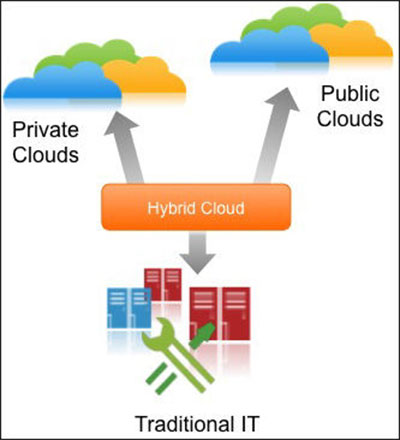Cloud, the promise of a new agility for Information Systems (IS) now comes in many different ways. But whether public, private or hybrid, it meets the same basic criteria: resource pooling, dynamic capacity allocation, usage billing.
If the private cloud raises some concerns of CIOs related to the opening of the public cloud, it restricts access to almost unlimited resources. The hybrid cloud is a means to combine the best of both worlds, especially in a homogeneous environment. Thus, it remains to imagine the right balance and the medium-term between the different models.

Private cloud and public cloud have appeared in conjunction with different services and software programs. It is time for reconciliation to meet new business needs and wants: fast pace of migration of existing when going into the public cloud, reversibility of such an approach, choice of data location and applications according to their criticality and sensitivity, using the public cloud for overflow or phases of development and testing.
Practically, it is to build a hybrid cloud, yet IaaS (Infrastructure as a service), which is to deploy a private cloud, which is then connected to it that are compatible with public cloud services.
PRIVATE CLOUD: OVERLAY-BASED NETWORK VIRTUALISATION
Massive virtualization data centre is the prerequisite for the deployment of a private cloud. Above the hypervisor, it is then to deploy a portal to services and a catalogue that lets users to request resources (virtual servers, network, storage, operating systems or applications) and t charge back systems (or a minimum of the value) internally. On the other hand, an orchestration tool will automate the provision of these resources. All these functions are covered by the Microsoft System Centre 2012 and Windows Server 2012. At Citrix, it is Cloud Platform, while VMware vCloud Suite offers it. Moreover, manufacturers like HP, IBM, Dell, or Oracle commercialize hardware bundles / software preconfigured private cloud, frequently partnering with Microsoft or VMware.
HYBRID CLOUD: MULTIPLE INITIATIVES WITHOUT STANDARDISATION
The perfect hybrid cloud will make sure seamless connection, the private cloud to any public cloud, and that on several levels. At the outset, a single portal will reserve resources and position them either internally or on the public cloud. Internal and external resources, on the other hand, can interact together. Lastly, these resources should be capable of easily moving from the private cloud to the public cloud.
This vision takes shape today, provided that the same technology is employed on both sides. As an instance, a private cloud-based offering enables Microsoft, through the mechanisms Azure Connect and Azure Service Bus built into Windows Server 2012 to deploy a hybrid infrastructure, developed in Visual Studio. There is another example, bricks open source CloudStack component let hybrid services, offered by HP or CloudWatt cloud.
As for interoperability between varied private and public clouds, it barely drafts via the APIs support public clouds. Now, if we can run VMs on the major public cloud, through open source libraries, such as Libcloud or Deltacloud, interoperability is not yet up to the capability of moving resources already deployed.
Author Bio:
John Kelly is a professional writer having more than 5 years of experience associated with Buy Essay Online. He also provide assistance to the students for competing their writing projects.
Private Cloud to Hybrid Cloud,





Charles
Dec 04. 2014
The tech cloud is our future of the Internet. Private cloud are great for personal backup